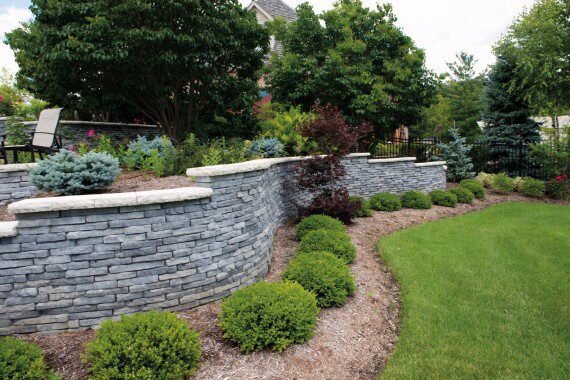Retaining Walls: Enhancing Aesthetics and Functionality in Your Yard

Retaining walls are essential landscape features that combine practicality with aesthetics. Whether you aim to prevent soil erosion, create a terraced garden, or add an attractive feature to your outdoor space, retaining walls can transform your yard into a functional and visually appealing area.
In this comprehensive guide, we will explore the various aspects of retaining walls, from their types and materials to design considerations and maintenance tips, ensuring your yard benefits from their full potential.
Understanding Retaining Walls
What is a Retaining Wall?
A retaining walls is a structure designed to hold back soil, preventing it from shifting or eroding. These walls are essential in areas with significant elevation changes, providing stability and allowing for the creation of flat, usable spaces on sloped terrain.
Benefits of Retaining Walls
Retaining walls offer numerous advantages, including:
- Erosion Control: Prevents soil from washing away, especially in areas prone to heavy rainfall.
- Increased Usable Space: Creates level areas for gardening, patios, or play areas on sloped properties.
- Aesthetic Appeal: Adds structure and visual interest to your landscape design.
- Structural Support: Provides necessary support to prevent soil collapse and protect your property.
- Increased Property Value: Enhances the overall appeal and functionality of your yard, potentially increasing property value.
Types of Retaining Walls
Retaining walls come in various types, each with unique features and suitable applications. Understanding these types will help you choose the right one for your yard.
Gravity Retaining Walls
Gravity walls rely on their mass to resist pressure from the soil behind them. They are typically made from heavy materials such as concrete, stone, or brick.
Features:
- Thick Base: The base is thicker than the top to ensure stability.
- Straight or Curved: Can be designed in straight or curved shapes.
- Simple Construction: Often easier to construct than other types.
Cantilevered Retaining Walls
Cantilevered walls are reinforced with steel bars and use the weight of the soil above their base to provide additional stability. They are usually constructed from concrete.
Features:
- Efficient Design: Uses less material than gravity walls.
- Suitable for Taller Walls: Ideal for walls over 10 feet in height.
- Strong Support: Provides significant structural support.
Sheet Pile Retaining Walls
Sheet pile walls are made from steel, vinyl, or wood planks driven into the ground. They are commonly used in areas with soft soil or tight spaces.
Features:
- Slim Design: Takes up less space than other types.
- Deep Foundation: Requires deep foundation for stability.
- Flexible Materials: Can be constructed from various materials.
Anchored Retaining Walls
Anchored walls use cables or rods anchored in the rock or soil behind the wall to provide extra support. They are suitable for high-load conditions.
Features:
- High Strength: Provides additional strength and stability.
- Versatile Applications: Can be used in various soil conditions.
- Complex Construction: Requires more advanced construction techniques.
Segmental Retaining Walls
Segmental walls are built from interlocking blocks that do not require mortar. They are popular for DIY projects due to their ease of installation.
Features:
- Interlocking Design: Blocks fit together for added stability.
- DIY Friendly: Suitable for do-it-yourself projects.
- Variety of Styles: Available in various styles and colors.
Choosing the Right Material
The choice of material for your retaining wall significantly impacts its appearance, durability, and cost. Here are some common materials used in retaining wall construction:
Concrete
Concrete is a versatile and durable material, suitable for various retaining wall types.
Advantages:
- Durability: Long-lasting and resistant to weather conditions.
- Flexibility: Can be molded into various shapes and designs.
- Low Maintenance: Requires minimal upkeep.
Stone
Natural stone offers a timeless and elegant look, ideal for aesthetic purposes.
Advantages:
- Aesthetic Appeal: Provides a natural and classic appearance.
- Strength: Highly durable and strong.
- Variety: Available in different colors and textures.
Brick
Brick retaining walls add a traditional and refined look to your yard.
Advantages:
- Classic Look: Timeless and elegant.
- Durability: Long-lasting and weather-resistant.
- Customization: Available in various colors and sizes.
Timber
Timber is an affordable and easy-to-install option for retaining walls.
Advantages:
- Cost-Effective: Generally less expensive than other materials.
- Easy Installation: Simple to work with, ideal for DIY projects.
- Natural Appearance: Blends well with outdoor environments.
Gabion
Gabion walls are constructed from wire cages filled with stones or other materials.
Advantages:
- Flexibility: Can be filled with various materials for different looks.
- Stability: Provides excellent stability and drainage.
- Eco-Friendly: Uses natural or recycled materials.
Design Considerations
Designing a retaining wall involves several factors to ensure functionality and aesthetics. Here are key considerations to keep in mind:
Assessing Soil Type
Understanding the soil type in your yard is crucial for choosing the appropriate retaining wall design and material. Different soils have varying load-bearing capacities and drainage properties.
Drainage Solutions
Proper drainage is essential to prevent water buildup behind the wall, which can cause pressure and lead to failure. Consider integrating weep holes, drainage pipes, or gravel backfill into your design.
Wall Height
The height of your retaining wall affects its design and stability. Taller walls may require engineering expertise and additional support mechanisms.
Aesthetic Integration
Ensure your retaining wall complements the overall landscape design. Consider the following:
- Color and Texture: Choose materials that match or contrast attractively with your existing features.
- Plant Integration: Incorporate plants or vines to soften the look of the wall and enhance its natural appeal.
- Lighting: Add outdoor lighting to highlight the wall and improve safety.
Building Codes and Regulations
Check local building codes and regulations before starting construction. Some areas require permits for retaining walls over a certain height or specific engineering standards.
Installation Process
Building a retaining wall involves several steps, whether you’re tackling it as a DIY project or hiring professionals.
Planning and Design
- Site Assessment: Evaluate the area where the wall will be built.
- Material Selection: Choose the appropriate materials based on your needs and preferences.
- Design Layout: Create a detailed design and layout plan.
Excavation and Foundation
- Marking the Area: Mark the outline of the wall using stakes and string.
- Excavation: Dig a trench for the foundation, ensuring it’s deep enough for stability.
- Foundation Preparation: Add a layer of gravel or crushed stone to the trench for drainage.
Building the Wall
- Laying the Base: Start with the base layer, ensuring it’s level and stable.
- Layering: Continue building the wall layer by layer, ensuring each layer is level.
- Reinforcement: Add reinforcement as needed, such as steel bars or geogrid.
Backfilling and Drainage
- Backfilling: Add gravel or soil behind the wall in layers, compacting each layer.
- Drainage Installation: Incorporate drainage solutions like pipes or weep holes.
Finishing Touches
- Capping: Add capstones or finish the top of the wall for a polished look.
- Landscaping: Integrate plants, mulch, or other landscaping elements.
Maintenance Tips
Proper maintenance ensures the longevity and appearance of your retaining wall. Here are some tips to keep it in excellent condition:
Regular Inspection
- Check for Cracks: Look for any cracks or signs of movement.
- Assess Drainage: Ensure drainage systems are functioning correctly.
- Monitor Vegetation: Trim any plants growing on or near the wall that could cause damage.
Cleaning
- Remove Debris: Clear away leaves, dirt, and other debris that can accumulate.
- Pressure Washing: For concrete or stone walls, use a pressure washer to remove stains and buildup.
Repairs
- Fill Cracks: Use appropriate materials to fill any cracks or gaps.
- Reinforcement: Add extra support if you notice any bulging or leaning.
Conclusion
Retaining walls are versatile structures that enhance both the functionality and aesthetics of your yard. By understanding the different types, materials, and design considerations, you can create a retaining wall that not only serves a practical purpose but also adds beauty to your outdoor space. Proper installation and regular maintenance will ensure your retaining wall remains a valuable asset to your landscape for years to come.





